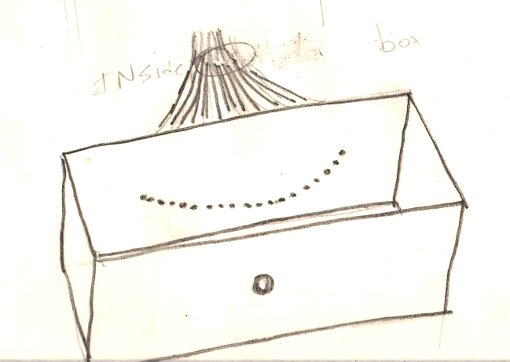Clock Project Part 2
In yesterday’s post I never gave a clear idea of what the finished clock would look like. I intend for it to look like the picture above. The time will be indicated to the nearest 15 minutes or 7.5 minutes if the sunlight happens to be landing on two optical fibers as I intend for it to do if things go right at times like 12:07, 12:22, 12:37 … There is a lever sticking out of the side of the clock. This lever is there to allow you to adjust the clock when daylight savings time rears its ugly head. By rotating the lever you rotate the locations of the optical fibers by one hour.
The sketch above is a side view of the solar clock. On the outside of the building there will be a ‘collection box’ that will direct sunlight onto one or two of the optical fibers at a time. The box continues all the way to the wall so that sunlight can’t hit the fibers. I have found that light is collected even if sunlight hits the fiber edge on. The box is adjustable so that as the year progresses, you can aim it so that as the sun goes higher and lower in the sky you will still be able to use the clock. I’m guessing that you will need to do this every week or two to keep things working properly.
This sketch is of the collection box with its top removed. The optical fibers are in an arc along the back of the box. There is a hole in the front of the box that allows the light to enter. This sketch is somewhat simplified. I have been tracking the sun using a test setup today and it is looking like it might be better to have the material that the optical fibers attach to be in an arc itself because the 15-minute increments are more widely spaced in the beginning of the day than they are at high noon. Ideally, the optical fibers would be placed so that they were in perfect alignment in September or March during the equinox so that you have the greatest accuracy.



December 3, 2011 at 3:27 AM
Aaargh!!!
I was thinking about the complexity of this project, but it’s perfectly simple, but different from how you describe it!
First some sundial basics. The sundial is aligned with the earth’s axis. So whenever the earth has turned 1 day, the shadow of a stick falls on the same spot. However, a few months later the sun will be higher or lower in the sky. The sundial is built such that it doesn’t matter how high the sun is, there will still be a shadow in the right spot….
But now your pinhole camera… You can align it in such a way that the fiber for 1 PM gets lit today at 1PM. However a few days from now the sun will be lower (in the northern hemisphere and you’ll have to add another fiber going from that spot to 1PM on your display. Lots of work, lots of fibers!
The trick is not to use a pinhole, but a slit. If you need multiple fibers to get enough light, you can position them in the same direction as the slit. Simple!!!
Good luck. Let me know how it goes!
December 19, 2011 at 10:24 AM
How much do the seasonal changes in sun position affect accuracy? The sun’s zenith isn’t always “noon,” and the actual position of the sun’s zenith changes throughout the seasons (http://en.wikipedia.org/wiki/Analemma). Would it just run like 15 minutes fast or slow in the off seasons?